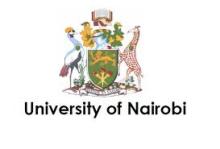Resource information
A study was undertaken along land use gradients in Taita-Taveta district, southeast Kenya to evaluate the occurrence of arbuscular mycorrhizal fungi (AMF) in seven land use types (LUT). The gradient was from indigenous forest (IF) to croplands with coffee (CO), maize (MA), horticulture (HT), napier (NA) and planted forest (PF). A total of 12 AMF morphotypes comprising of 4 Glomus, 1 Claroideoglomus, 5 Acaulosporaceae, 1 Racocetra sp. and 1 Gigaspora were isolated from the study site. Occurrnace of
Acaulospora denticulata, Glomus ambisporum and Claroideoglomus etunicatum was significantly (p < 0.05) affected by LUT; A. denticulata, Acaulospora laevis, G. ambisporum, Glomus sp. 1, Glomus sp. 2 and Gigaspora margarita were common in all LUT; C. etunicatum and Glomus sp. 3 were restricted and Acaulospora scrobiculata and two additional undescribed morpotypes were found only in trap cultures. Mean spore
abundance was significantly (p = 0.007) different in cropped systems with CO (35), HT (36.6) and MA (41.7) recording lower mean spore abundance compared to non-cropped systems with PF (130), NA (91.3), FA (89.7) and NA (84.3). AMF species showed preference for either cropped or non-cropping systems and species diversity and richness were maintained despite dramatic changes in LUT.



